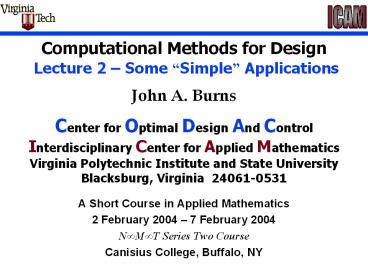Computational Methods for Design Lecture 2 - PowerPoint PPT Presentation
1 / 39
Title:
Computational Methods for Design Lecture 2
Description:
Title: Sensitivities in OptimalDesign Author: John Burns Last modified by: burns Created Date: 11/24/1997 4:19:52 PM Document presentation format – PowerPoint PPT presentation
Number of Views:115
Avg rating:3.0/5.0
Title: Computational Methods for Design Lecture 2
1
Computational Methods for Design Lecture 2
Some Simple ApplicationsJohn A. BurnsCenter
for Optimal Design And ControlInterdisciplinary
Center for Applied MathematicsVirginia
Polytechnic Institute and State
UniversityBlacksburg, Virginia 24061-0531
- A Short Course in Applied Mathematics
- 2 February 2004 7 February 2004
- N8M8T Series Two Course
- Canisius College, Buffalo, NY
2
Todays Topics
3
A Falling Object
Newtons Second Law
WARNING !! THIS IS A SPECIAL CASE !!
4
A Falling Object (constant mass)
5
A Falling Object Problems?
6
A Falling Object Problems?
7
Terminal Velocity
FOR A FALLING OBJECT
8
Terminal Velocity
9
Comments About Modeling
Newtons Second Law IS Fundamental
- TWO PROBLEMS
- FINDING ALL THE FORCES (OF IMPORTANCE)
- KNOWING HOW MASS DEPENDS ON VELOCITY
ASSUMING CONSTANT MASS
CORRECTION FOR AIR RESISTANCE
THE MODEL FOR AIR RESISTANCE IS AN
APPROXIMATION TO REALITY
10
More Fundamental Physics
- ? HOW DOES THE MASS DEPENDS ON VELOCITY ?
FOLLOWS FORM EINSTEINS FAMOUS ASSUMPTION
11
More Fundamental Physics
EINSTEINS CORRECTED FORMULA
12
Comments About Mathematics
MATHEMATICIANS MUST DEVELOP NEW MATHEMATICS TO
DEAL WITH THE MORE COMPLEX PROBLEMS AND MODELS
13
Comments About Modeling
MORE ACCURATE MORE COMPLEX MORE DIFFICULT
14
Population Dynamics
- Use growth of protozoa as example
- A population could be
- Bacteria, Viruses
- Cells (Cancer, T-cells )
- People, Fish, Cows Fish
- Things that live and die
ASSUME PLENTY OF FOOD AND SPACE
15
Population Dynamics
Change in cell population
Thomas R. Malthus (1766-1834)
16
Population Dynamics
17
Population After 5 Days
18
Population After 7.5 Days
19
Population After 10 days
NOT WHAT REALLY HAPPENS
20
Improved Model
Malthus ASSUMED PLENTY OF FOOD AND SPACE
COMPETITION FOR FOOD AND SPACE
21
Logistics Equation
22
A Comparison First 5 Days
23
A Comparison First 7.5 Days
24
A Comparison First 10 Days
25
Logistic Equation 15 Days
26
Modeling in Biology
Logistic LAW of population growth
Malthusian LAW of population growth
? WHAT HAVE WE LEFT OUT ? ? WHAT IS THE CORRECT
LAW ?
NEED A NEWTON OR EINSTEIN FOR SYSTEM BIOLOGY
MORE ACCURATE MORE COMPLEX MORE DIFFICULT
27
A Smallpox Inoculation Problem
- Basic issue Compute the gain in life expectancy
if smallpox eliminated as a cause if death? - Very timely problem
- What if smallpox is injected into a large city?
- How does age impact the problem?
28
A Smallpox Inoculation Model
- Typical epidemiological model
- Contains age dependent coefficients
- Model applied to Paris
- Not funded by Dept. of Homeland Defense
- Work was done in 1760 and published in 1766 by
Daniel Bernoulli, Essai dune nouvelle analyse
de la mortalité causée par la petite vérole,
Mém. Math. Phys. Acad. Roy. Sci., Paris, (1766),1.
29
Predator - Prey Models
- Vito Volterra Model (1925)
- Alfred Lotka Model (1926)
- THINK OF SHARKS AND SHARK FOOD
30
Numerical Issues LV Model
- Numerical Schemes?
- Explicit Euler?
- Implicit Euler?
- ODE23?
- ODE45?
- ??????
31
Symplectic Methods
Explicit Euler
Symplectic
Implicit Euler
gt
gt
32
Epidemic Models
33
Epidemic Models
- SIR Models (Kermak McKendrick, 1927)
- Susceptible Infected Recovered/Removed
34
SIR Models
NOT ISOLATED
35
SIR Model
S(t) I(t) N 1
I(t)
S(t)
36
Epidemic Models (SARS)
- SEIJR Susceptibles Exposed - Infected -
Removed
Model of SARS Outbreak in Canada by Chowell,
Fenimore, Castillo-Garsow Castillo-Chavez (J.
Theo. Bio.)
- Multiple cities (patch models)
- Hyman
- Mass transportation
- Castillo-Chavez, Song, Zhang
- Delays
- Banks, Cushing, May, Levin
- Migration Spatial effects
- Aronson, Diekmann, Hadeler, Kendall, Murray, Wu
37
Spatial Model I
- OCallaghan and Murray (J. Mathematical Biology
2002) - Spatial Epidemic Model
- Partial-Integro-Differential
Equations
NON-NORMAL
38
Spatial Model II
WHERE A generates a delay semi-group
39
Remarks
- LOTS OF SIMPLE APPLICATIONS
- OPPORTUNITIES FOR MATHEMATICIANS TO GET INVOLVED
WITH MODELING - JOB SECURITY FOR APPLIED MATHEMATICIANS
- NEW MODELS NEED TO BE DEVELOPED TOGETHER
MATHEMATICIANS WITH - PHYSICS, CHEMISTRY, BIOLOGY
- FLUID DYNAMICS, STRUCTURAL DYNAMICS
- GOOD COMPUTATIONAL MATHEMATICS WILL BE THE KEY TO
FUTURE BREAKTHROUGHS - APPROXIMATIONS MUST BE DONE RIGHT
















![Innovative Methods Computer Assisted Instruction [ CAI ] PowerPoint PPT Presentation](https://s3.amazonaws.com/images.powershow.com/6402049.th0.jpg?_=201504091211)














